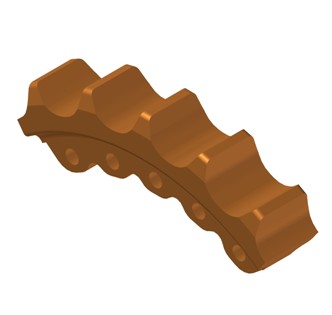The difference between forged and cast segments of a driving wheel of a bulldozer or excavator. Let’s try to answer the question: “Original, high-quality analog, or products of unknown production?”. So, let’s take a look at this issue in order using the example of the 17M-27-41630 sector under the KROT brand for the Komatsu D275A-5 bulldozer. This article may contain inaccuracies. Comments are welcome.
1. Manufacturing method. Forged sectors are manufactured by die forging. The workpiece has a uniform, “dense” metal structure. This method is more expensive than the casting one. The cast sector in the manufacturing process cannot be protected from the appearance of gas pores of various sizes, therefore, products of unknown manufacturers do not have tooth processing after casting, as a result of which the porous structure of the metal will appear, which significantly reduces the service life of the sector. Furthermore, the absence of the tooth milling (the ideal geometry of the tooth and its base) affects the wear of the track bushing. For reference, the first tooth of the sector in the direction of travel of the machine carries a load of 85%; the remaining 15% are distributed evenly between 2, 3, and 4 teeth.
2. Applied material. Serious manufacturers do not indicate the steel grade. Unscrupulous manufacturers make of steel 40Mn or 50Mn. This material is difficult for heat treatment—it is easy to under-temper or overtemper, as a result of which the metal becomes brittle. We use a forging of steel 40MnMoVB—a material containing manganese, molybdenum, tungsten, and boron, or 38CrSi.
3. Heat treatment. This is one of the main differences. We carry out heat treatment of products by induction hardening, and at the output, we have a hardness of 53-58HRC. Cast sectors are being bulk hardening. The hardness gauge measurements show hardness at 47HRC. What is the difference in hardening method? Induction hardening ignites the working area of the sector where the maximum stresses occur on the surface of the sector. Increasing the hardness and strength of the surface contributes to the efficiency of the entire part as a whole. Also, the use of induction hardening reduces the brittleness of the part. Due to its durable, solid surface, a relatively ductile and plastic core of the sector is maintained. This cannot be achieved with through bulk hardening. As a result, everyone decides for himself, which sectors to use. This is just that objective information on how the original sectors and high-quality counterparts are made, as well as cheap cast ones. The good does not come cheap.
